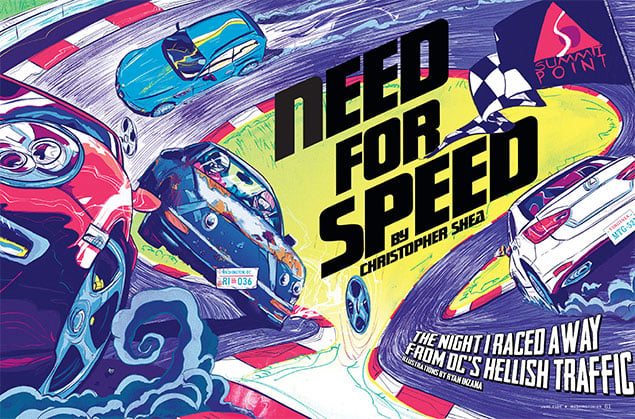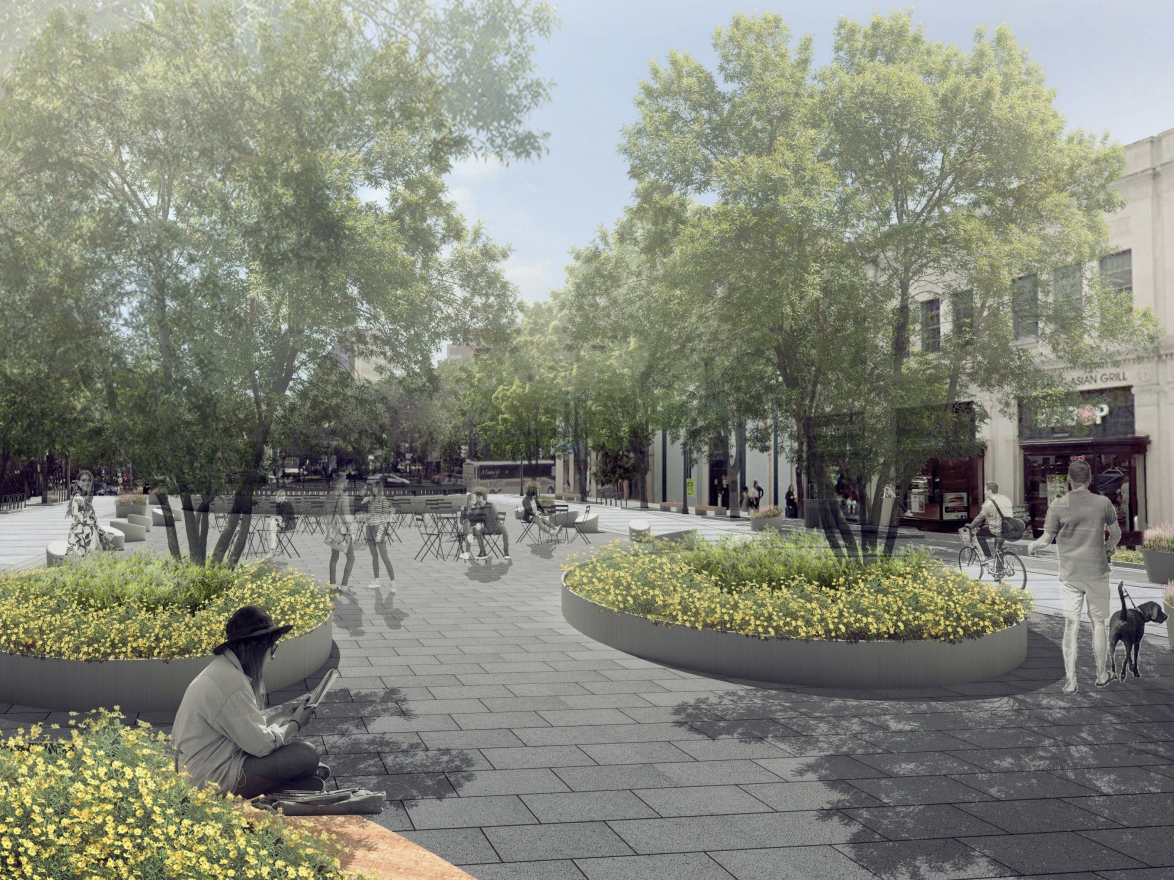The 140-horsepower engine in my little 1995 Acura Integra isn’t exactly roaring, but it is snarling nicely. I’m coming out of the 90-degree right-hand turn onto a 2,900-foot straightaway at Summit Point Motorsports Park’s main track, my knee braced hard against the side door, body tense, pores emitting copious sweat. “Look toward the billboard on the left,” the instructor in my passenger seat says through the headsets wired to our helmets.
The track is loud. There’s engine noise, the squeal of tires straining against high G-forces, and the abiding whoosh of air turbulence. We’re driving with the windows open so we can hand-signal to other drivers—and so that the EMTs who are on standby would have an easier time rescuing us if we crashed.
Looking far ahead, always, is the first rule of thumb in car racing, and at this moment that billboard 100 or so yards away is my target. Putting eyes on it helps draw me to the far left of the track, so that I use as much of it as I can, smoothing out the turn. The track is two miles long with ten turns, and the straightaway is my chance to build up some speed: 80 . . . 90 . . . 100 miles per hour.
On the left are a series of signs marking 500 feet, 400 feet, 300 feet, the distance to a hairpin right turn. I’m to start braking at the 500 mark.
But I don’t do it firmly enough, and I hear about it from my instructor: “More brake, more brake, more brake, MORE BRAKE!”
Then: “Turn tight right. . . . A little bit early on that. Eyes up to the outside edge—let the car go all the way to the outside edge.”
I slip in a frantic downshift, hit the gas.
A thousand feet down the track, the routine begins again—a left turn this time: “Braking, braking, braking, braking, BRAKING!”
• • •
The sights and sounds are straight from a video game, but the action at Summit Point is real, and anyone is welcome to check it out.
I’m here partly for selfish reasons. I’ve long been a vicarious car buff, reading in Car and Driver about the balanced chassis and perfect track manners of the BMW M-series, absorbing a trunkful of car-guy lingo. I’m a manual-transmission snob, and yes—I do think I’m a pretty good driver. But I’ve never done much more than take highway exit ramps kind of fast, or maybe sneak it up to 90 on a remote highway. Because I work from home, I don’t even commute.
What I do is schlep my son and his classmate from Hyattsville up to school in College Park several times a week through a half dozen stoplights. The closest I get to fun is when Kenilworth Avenue opens to 50 mph for a couple minutes. My main car is a Mazda5 familymobile, the Acura a holdover from my twenties.
I’m also here because I suspect that hitting the track is something a lot of Washingtonians itch to do. That our region is full of repressed drivers: people who only ever deploy their high-performance rides in stop-and-go traffic on the Beltway.
In Washington, we are forever in cars—yet we rarely really drive.
At Summit Point, the fastest cars can flirt with 150 mph on the straightaway.
• • •
The track is no NASCAR raceway, but it does have a semi-storied past. Paul Newman raced here after he took up the sport. And it’s close. In West Virginia’s eastern panhandle, it’s just 90 minutes from DC, an hour from Dulles.
The raceway generally opens its course once a week to novices and track hounds. There are few restrictions to showing up—namely, high-riding cars like SUVs and minivans aren’t allowed. Requirements? A safety inspection, on-site. Other than that, just the willingness to put a little wear on your brake pads and tires.
In my case, rolling onto the Summit Point grounds is initially intimidating, because I can tell that the cars I spot first—a red Porsche 911 GT3 (a veritable supercar) and a silver BMW M6—cost many multiples of my 19-year-old dented sedan with patchy paint and a (working!) cassette player.
But by the end of the night, seven drivers in all will show up—two with Golf GTIs, a bit closer to my tax bracket.
After signing in, and no doubt signing away various rights to sue, I make my way to a grassy staging area, where people are dumping things like spare tires and jacks on the grass, ridding themselves of excess, speed-stealing weight. I opt not to do this.
The safety mechanic gives my car a once-over. “I haven’t seen wheels that small in a while,” he says.
Every driver gets paired with an instructor. Mine is David Van Diest—a.k.a. “DVD”—a muscled, genial, Oakley-sporting guy with a yellow-and-black 444-horsepower Boss 302 Mustang parked nearby. He’s to take the wheel and give me a driving tour of the track.
But first we remove all the loose stuff floating around in my car. In a 105-mph crash, even my notebook and pen could become face-lacerating projectiles.
“My wife thinks I’m crazy for doing this,” DVD says.
After the first two turns—the one ending at the straightaway and the hard left following it—the course meanders 1,000 feet, climbing then diving rightward and downward. At the bottom of the hill comes a speed-draining one-two punch of an extreme left and then an extreme right “carousel” turn. From there it’s a sinuous ride to an uphill section of straight track that passes a gazebo and an overpass—then you turn back onto the straightaway.
The first time DVD takes me through the course, all is cool. Mellow, even, and I wonder why he doesn’t downshift more often.
Careful what you wish for.
The second ride is so fast my stomach drops to the asphalt at every turn. So much road, such speed, the wheels kissing one track edge and then the other.
After that loop, DVD punches his fist up over the car, the signal to other drivers that we’re leaving the track. We roll to a stop.
“How was it?” he asks.
“A little more intense than I expected.”
He tries to reassure me: “We’re going to make sure your car leaves in the condition you brought it in.”
• • •
The basics of DVD’s instructions sound easy enough: As a right turn approaches, you “preset” by moving the right hand from 3 o’clock to 12 o’clock on the steering wheel. This prevents excessive bodily contortions as you turn. You brake hard and early, harder and earlier than feels natural. (The technical term is “threshold” braking.) You turn tightly, but smoothly, so you hit the apex of the inside corner, helpfully marked by red and white paint. Then you let the car drift back to the far left of the track as you hammer the gas.
Part of the challenge, though, is the varied nature of the turns. Because this isn’t an oval, each demands a slightly different angle of attack. I’m perpetually too fast and late on the straightaway ending turn 1. Ditto for turn 2. “It’s like you’ve got a mental block,” DVD says.
The turn-5/turn-6 “carousel” combination is a lost cause. I meander through, all thoughts of a clean line lost. The stretch that includes gentle 7, 8, and 9, climaxing with turn 10 onto the straightaway, is a chance to get rolling again.
“Stay left, stay left,” DVD says as I come out of number 8. “Eyes on the hill—look for that gazebo on the left. . . . Drive to the gazebo!”
A quick clutch depress and rowing of the shifter.
“Go to the left now . . . . Yes. . . . Now to the middle of the bridge.”
Suddenly there’s an overpowering engine note in the air, symphonic Wagner to my Acura’s kazoo, and I look up in the rearview mirror to find it filled with the leering face of a Porsche. I punch my fist out the window and up over the car, slow down, and move out of its way to the left.
“We call it the red mist,” DVD says, and warns me not to get competitive.
I am distracted—he’s right. But not by testosterone-fueled aggression. It’s just that watching a Porsche glide through a fierce, arced turn is a beautiful sight.
“Breathe,” DVD says. He’s full of these helpful reminders.
Every few laps, we have to stop. My small, ancient brakes wouldn’t hold up otherwise. Some unusual things I learn during our pit stops: Don’t wrap your thumbs around the steering wheel, especially near the crossbars, because if you lose control of the car, your thumbs can snap.
Never apply the emergency brake during pit stops, because that can warp the scorching rotors.
Your car will go through fuel at double its normal rate.
Turn entrances, apexes, exits, presets, braking downshifts—it’s a lot to keep track of. DVD emphasizes looking ahead the most.
“The more time you have to think about what’s coming up, the better and smoother you’re going to be,” he says. “That works fantastic on the track, but it also works fantastic on the street, in terms of keeping you safe and keeping you out of accidents.
“And it might help you avoid a ticket or two.”
• • •
I have one close call.
At one point, my left front tire slips off the track exiting turn 1. DVD reaches over with his left hand and guides the car back onto asphalt before I have a chance to react—or, worse, overreact, sending the car careening across the track.
On this same night, another driver, Gary Martinez—an architect from Annapolis and a member of the Chesapeake region’s Porsche club—missed a shift at the end of the straightaway. He looked down, got distracted, and in that instant ran out of road. He was lucky. Or good. He was able to guide his Porsche Carrera 4S to a controlled stop in the grass, suffering only splashes of mud on his doors.
Three times during my training, DVD grades me using a 1-to-5 scale across three areas: “mental,” “physical skills,” and “safety.” I move from across-the-board 1s to 3s. I suspect some social promotion.
All things considered, the track felt surprisingly democratic. I even learn later that skilled drivers of small-engine, agile cars like $24,000 Mazda Miatas take pleasure in catching up to Corvettes on the track’s tight passages after getting blown out on the straightaways.
The biggest thing I learned is that I’m not a very good driver. (Also, that almost everyone overestimates his or her prowess behind the wheel.) I never was able to put together a run with even five good turns. Yet the handful I nailed felt sublime in the way swishing a three-pointer does.
A fellow newbie, Brian Russell, driving a 2010 Golf GTI, put it another way. “Your mind is so focused on one thing, it’s a strange feeling,” he told me that night. “It’s almost calming.”
At least until you think you might not make a corner.
At the end of my night, as I sat in the Summit Point parking lot preparing to drive home, I kept panicking that I’d left something—sunglasses, my cell phone—back in the racecar.
Of course, I was sitting in the racecar.
Christopher Shea (cshea2@gmail.com) is a contributing writer for the Chronicle of Higher Education. This article appears in the June 2014 issue of Washingtonian.
















